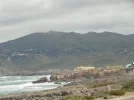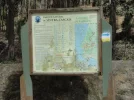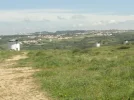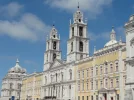The “Caminho do Mar”, is a pilgrimage route, fully identified and signalized with blue and yellow arrows and in some cases with landmarks from the door of the Church of Estoril (St. Anthony's Church), to Fatima and if the the Pilgrims wishing may go to Santiago de Compostela, the Caminho Central to Santiago (by Ansião) or Caminho Nascente (by Tomar).
More than 80% of the route is either off-road or for municipal roads, virtually without traffic. It is of rare beauty and you will find many moments of contemplation and silence all the way.
The “Caminho do Mar”, is signposted from the day April 27, 2013. And the total route between Estoril and Fátima is around 205 kms.
CAMINHO DO MAR:
http://www.cnc.pt/artigo/3126
A route preferably off-road to avoid traffic and road hazard, but also so that the path to provide an environment Pilgrims but contemplative. Obviously always crossing locations that could provide logistical support.
About the historical background, how do you know the way to Fatima has about 100 years. But the Camino de Santiago has more than 1,000.
We based the identification of this pathway in the tradition of pilgrims who came from Lisbon by land or sea to Cascais, stayed overnight in the convent of St. Jerome in the Penha Longa and continued by Sintra, Mafra, Torres Vedras, Caldas Rainha, etc ....
There are historical records, one of the connoisseurs of this tradition and reality is Prof. Vitor Manuel Adrião, a historian and published books on the subject, such as the book "Santiago de Compostela - Mysteries of the Portuguese Route."
Inflection for Fatima, is a tradition of the last 100 years, of the people that the path crosses.
Further proof of tradition and existence of this path, you will find a printed image on the Credential Pilgrim provided by the Archdiocese of Santiago de Compostela.
I take this opportunity to inform you that are already flagged the path Nazaré to Fatima, joining the two Marian Shrines.
CAMINHO NAZARÉ - FÁTIMA
http://www.cnc.pt/artigo/3127
We are currently create awareness and stimulate entities to open albergues for pilgrims. However, and while there are no albergues the “Caminho do Mar” ask in the name of the CNC accommodation establishments along the Camino the route of the Sea, which had some special conditions.
In the document there is information about the accommodation. But more than doing a special price, we know that these lodgings accomodate with affection the pilgrims.
CENTRO NACIONAL DE CULTURA:
http://www.cnc.pt/artigo/15
CAMINHO FÁTIMA – TOMAR (Caminho Nascente)
http://caminho.com.pt/mapas.html
http://www.gpsies.com/map.do?fileId=izsolapzyxmspdfp&language=pt
AND
CAMINHO FÁTIMA – ANSIÃO (Caminho Central to Santiago)
http://caminho.com.pt/mapas.html
https://www.facebook.com/amigosdocaminho?fref=photo
http://www.cnc.pt/artigo/3125
PS. The shorter steps are indicated with red color and are intended to pilgrims who do not intend to make more than 20 km daily. These stages were selected based on the accommodation and transport existence (bus or train).
I also take this opportunity to indicate villages with tourist interest.
More than 80% of the route is either off-road or for municipal roads, virtually without traffic. It is of rare beauty and you will find many moments of contemplation and silence all the way.
The “Caminho do Mar”, is signposted from the day April 27, 2013. And the total route between Estoril and Fátima is around 205 kms.
CAMINHO DO MAR:
http://www.cnc.pt/artigo/3126
A route preferably off-road to avoid traffic and road hazard, but also so that the path to provide an environment Pilgrims but contemplative. Obviously always crossing locations that could provide logistical support.
About the historical background, how do you know the way to Fatima has about 100 years. But the Camino de Santiago has more than 1,000.
We based the identification of this pathway in the tradition of pilgrims who came from Lisbon by land or sea to Cascais, stayed overnight in the convent of St. Jerome in the Penha Longa and continued by Sintra, Mafra, Torres Vedras, Caldas Rainha, etc ....
There are historical records, one of the connoisseurs of this tradition and reality is Prof. Vitor Manuel Adrião, a historian and published books on the subject, such as the book "Santiago de Compostela - Mysteries of the Portuguese Route."
Inflection for Fatima, is a tradition of the last 100 years, of the people that the path crosses.
Further proof of tradition and existence of this path, you will find a printed image on the Credential Pilgrim provided by the Archdiocese of Santiago de Compostela.
I take this opportunity to inform you that are already flagged the path Nazaré to Fatima, joining the two Marian Shrines.
CAMINHO NAZARÉ - FÁTIMA
http://www.cnc.pt/artigo/3127
We are currently create awareness and stimulate entities to open albergues for pilgrims. However, and while there are no albergues the “Caminho do Mar” ask in the name of the CNC accommodation establishments along the Camino the route of the Sea, which had some special conditions.
In the document there is information about the accommodation. But more than doing a special price, we know that these lodgings accomodate with affection the pilgrims.
CENTRO NACIONAL DE CULTURA:
http://www.cnc.pt/artigo/15
CAMINHO FÁTIMA – TOMAR (Caminho Nascente)
http://caminho.com.pt/mapas.html
http://www.gpsies.com/map.do?fileId=izsolapzyxmspdfp&language=pt
AND
CAMINHO FÁTIMA – ANSIÃO (Caminho Central to Santiago)
http://caminho.com.pt/mapas.html
https://www.facebook.com/amigosdocaminho?fref=photo
http://www.cnc.pt/artigo/3125
PS. The shorter steps are indicated with red color and are intended to pilgrims who do not intend to make more than 20 km daily. These stages were selected based on the accommodation and transport existence (bus or train).
I also take this opportunity to indicate villages with tourist interest.























